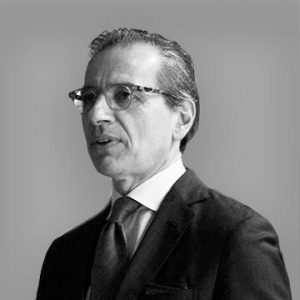
Armine, Gucci, influencers & unconventional beauty
Interview with Paolo Torello – Viera

PAOLO TORELLO-VIERA:
A longtime manager in fashion and textile industry, Paolo Torello-Viera was born in Biella and now lives in New York. He has been vice president in Ermenegildo Zegna, Chief operating officer (COO) in Brioni, COO in Samuelsohn, CEO of BVM Usa (Les Copains – Gian Battista Valli), CEO for Americas in Pal Zileri and CEO of Lanificio Fratellli Cerruti.
The story of Gucci’s model Armine Harutyynyan, trained and successful professional but surely not in accordance with the traditional beauty canons, has provoked a discussion between the supporters of the “unconventional beauty” and the supporters of the classical esthetical model on the runway. Actually, Armine’s case, brought to the fore and to the general public’s attention a trend – namely to bet on “unconventional beauty” models – which is already present in many fashion houses, not only in Gucci. What do you think of this debate and of this historical transition that is changing the fashion world? Which are in your opinion the strengths and the weaknesses of the traditional model compared to the new one?
This is a complex subject, and it is important to contextualize it first. With Armine, we are talking about the big fashion brand Gucci, which is not an ordinary fashion house: this brand made the unconventional a trademark since its very beginning. Gucci has a great team, there aren’t random choices, and it is a great mistake to see them as simple provocative actions to quickly dismiss. The case of Armine triggered a lot of different reactions, also inappropriate, led to misunderstandings, involved the generic public of non-experts and actually split the public opinion in two: the critics (sometimes very unpolite) and the supporters.
Personally, I think that Gucci’s decision to choose Armine was right. I believe that Armine Harutyunyan is a role model, and I am convinced that both her and Gucci’s team have shown great bravery and consistency in front of criticism. Gucci’s choice needs to be set in a broader historical period and I think that it can represent in an emblematic way an epochal change that the world of fashion and modelling are going through. Top models of Nineties and Eighties (like Naomi Campbell, Claudia Schiffer, Linda Evangelista, Christie Turlington, Karen Mulder, Heidi Klum) were just fabulous, beautiful women that embodied an historic fashion era that I will define as such: models used to add beauty to the dress, with a lot of charm and grace. However, they made the fashion world a parallel and golden reality, far away from common people and sometimes unreachable.
Afterwards, we’ve gone through the phase – now concluded – characterized by skinnier models, sometimes anorexics that used to vanish to put the dress in the spotlight. For girls and the female public in general they represented a very dangerous and unacceptable model.
Nowadays, we are in a phase that I will define as follows: models are becoming somehow “actresses”, namely they are chosen to portray in the best possible way the message that the fashion house wants to give. The emphasis is neither on the beauty and the perfection of aesthetical canons nor the dress itself, but there is a meaning that the stylist wants to send, a content that he would like to share.
Hence, we are talking about fashion paradigms that are changing during an era that cannot be defined “right” or “wrong” in absolute terms. However, it is meaningful to understand if a specific advertising, communication and reputation choice – in line with its own era – is reasonable, fair or not. Talking about the “beauty” or the “ugliness” of a model and complaining of how old times models used to be the most beautiful in the world while now they are not, means that you don’t know anything about the fashion world and you don’t understand the changes that it is going through.
During the phase we are living in, a period when the fashion world focuses on the messages that the brand wants to send, Gucci’s decision to hire the model Armine Harutyunyan is both reasonable and acceptable, because it conveys positive and important messages such as respect for everyone, walls breaking down, recognition of differences, promotion of diversity, accepting and loving yourself for what you are. Moreover, it also supports the integration and the valorization of a particular type of beauty that every man and woman has inside, regardless to all the rigid esthetical canons codified by the tradition (canons that often are very far from the way people look like in their ordinary life: who criticized Armine for her alleged ugliness is surely not an Adone or a Venus). The great message that Gucci wanted to send is that a woman or man are charming and interesting thanks to their own personalities, not to the comparison with rigid esthetical canons.
Usually only people mentally old people, linked to an old-fashioned fantasy, typical of Eighties and Nineties, regret the top models’ perfection of yesterday. Indeed the common perception of reality and the vision of the world is radically changing and young people are looking for content, storytelling and message.
Just yesterday, in preparation of this interview, I made an experiment with my sixteen-year-old daughter: I showed her two fashion advertisements, the first was the beautiful and standard one (in accordance with the old canons) of an established brand, and the second was the advertisement of a growing brand that puts eco-sustainability at the heart of its communication. My daughter expressed a strong preference for the second brand. At present we are living in the US and here the importance of sending educational, sympathetic and positive messages has grown enormously in the next few years (e.g. American athletes who recently stopped the championship to support protests against racism!). In Italy and Europe these trends are nowadays less important, but I think they will become established just like in the USA and awareness of young people here is already changing as well.
Beware, thought: for people, boys and girls the “façade”, the statements and the advertisements alone are not enough, they also need the essence. If a fashion brand focuses its communication on integration and sustainability issues, but it does not show consistency and real-life match with these spoken values, nowadays people will notice it and this will create a boomerang effect for the company itself.
Armine – Gucci case focuses on the issue of fashion marketing, in a world where it is fundamental to hit people’s imagination. In this context, how important is it the textile product itself? Is there any risk that the intrinsic quality of the dress will be overshadowed?
This question deals with a very interesting and fundamental topic. It is true, as I just said, that nowadays in the fashion world it is pointless to offer a garment only for its esthetical nature. Today clothes, as textiles upstream the supply chain, should be promoted in an indirect way, through a valorization that goes from messages and contents of different kind, with a well planned and studied storytelling. Now marketing, style and commercial are three departments in the same company who work together very closely, and textile companies cannot just show their collections to the customers. In fact, they have to work in the best way to promote and talk about their product, directly or indirectly.
However, this does not mean that the product can have a long-term success if it hasn’t a substantial quality. Also in this case the “facade” is not enough, because to last over the years a textile and fashion product needs to have a substance and an inherent value. Hence, it has to be made of high-quality raw materials and techniques, otherwise it can have at most good outcomes in the short-term, in a temporary way.
In this respect – let me say – Italy today has the chance of being ahead of everybody. Italy’s strength has always been linked to the high quality of its handcrafted textile offer and I think that the government institutions should understand that Made in Italy craftsmen need to be supported in order to prevent their extinction and allow Italy to keep its biggest strength: quality. Moreover, it is not accidental that foreign multinationals and big equity funds made “shopping “ with Italian textile companies in recent years. Clearly, global investors are well aware that Made in Italy still has great possibilities. Unluckily other people in Italy do not understand it yet. As Italian from Biella, even if today I live in the USA, I wish that Italians will become aware of how many opportunities we have today.
Which have been, during your long experience as manager in the textile industry, fashion brands’ decisions that impressed you the most in terms of originality and effectiveness?
Along the years I saw a lot of advertising campaigns and I experienced some of them in firsthand, as manager or CEO in textile and fashion companies. Here I would like to quote the advertising campaign of Ermenegildo Zegna that stated “At home anywhere in the world” with the photo of some costumes (spacesuits, football uniforms or diving suits), with the inclusion of a dress of Ermenegildo Zegna. This advertising was perfect in its simplicity and in its clear message related to inclusion, closeness to everybody, integration and valorization of different human personalities.
In general (not only in fashion and textile world), I am a great supporter of advertising where the main character is interesting and bears a positive message. For instance, I am thinking about Alex Zanardi, who is a great model of resilience and fortitude and embodies an important life ability: always looking at the full half of the glass (quoting Zanardi: “when I woke up with no legs I looked at the remaining part of my body, not at the missing one”). Alex, we are all supporting you in this further challenge.
I would also like to quote another person that I value highly, Vanni Oddera, champion of motocross freestyle who decided to help disabled children and suffering from “mototherapy”. For those who don’t know him yet, I suggest you follow him.
The fashion influencer, with millions of followers on their social profiles, are nowadays strategic subjects in brand promotions and in influencing new trends. To what extent are these new people changing the world of fashion?
The strategic importance of influencers nowadays is undeniable, not only in the fashion world. For instance, I was impressed by the fact that in London to create a big anti-Covid campaign many influencers have been hired (and paid). Namely, the British government understood that in order to convince people to adopt correct behaviors required by health authorities, the best choice was to employ influencers, star of social media and TV series.
The same applies in convincing people to buy clothes. But even then, a long-lasting success comes only when influencers are positive role models or at least have excelled in terms of social commitment. The fund raising of Fedez&Ferragni for the Covid emergency is a good example of what I stated before, it’s a concrete action that I really appreciated. On the other hand, when there is only a superficial appearance with no substance, the influencer will hardly last for a long period of time.
However, today the winning formula in the textile/fashion world in terms of marketing is a complex mix of B2B + B2C + Physical + Digital. A real ecosystem (nowadays we talk about a “Phygital” communication, that is online and offline integrated with the creation of a 360 degrees customer experience). The physical channel will never disappear and will always be fundamental, because the human being is a social animal and looks for a direct contact with others. However it is clear that the retail textile business is radically changing: forecasts say that in the next few years the 50% of turnovers will be made online, within the 50% of physical shops the 65% sales will be online and only the 35% will be realized in the conventional way.
In this context it is obvious that, relying on influencers with a great power on the social media is nowadays essential for all fashion houses.

